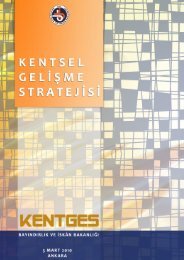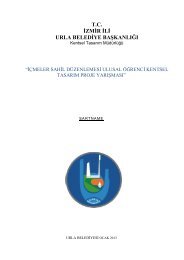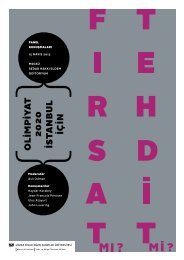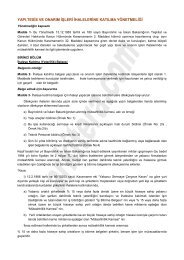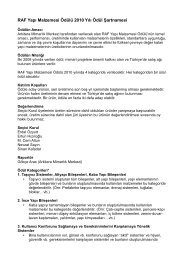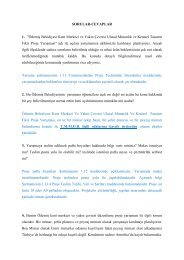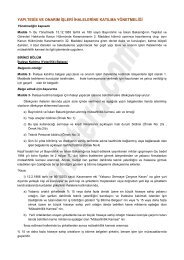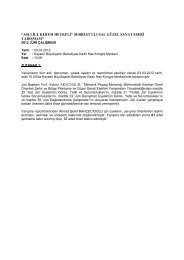VitrA ÃaÄdaÅ Mimarlık Dizisi - Arkitera
VitrA ÃaÄdaÅ Mimarlık Dizisi - Arkitera
VitrA ÃaÄdaÅ Mimarlık Dizisi - Arkitera
Create successful ePaper yourself
Turn your PDF publications into a flip-book with our unique Google optimized e-Paper software.
Barbarlar, Eros ve Uygarlık<br />
Alman felsefecisi Herbert Marcuse, 1955 tarihli kitabı Eros ve Uygarlık’ta, Freud ve Marx’a atıfla, doğa ile tarih,<br />
içgüdüler ile onların rasyonalite ilkesi tarafından bastırılması hakkında Freud’un ileri sürdüğü tezleri tartışır.<br />
Marcuse’ye göre çatışma, Freud’un ileri sürdüğü gibi doğal içgüdüler ile bunların toplumsal üst benlik tarafından<br />
bastırılarak enerjinin etkinliğe dönüştürülmesi arasında, yani çalışma (gerçekçilik ilkesi: aylaklığın dışlandığı yaşam)<br />
ile Eros (haz ilkesi: boş zaman ve zevk) arasında değildir. Ona göre kapitalist toplumda çatışma, sınıflı toplumu<br />
oluşturan performans ilkesi ile Eros arasındadır. İkincisi, sadece seçkinlere bahşedilir. Baskı altına alınmamış bir<br />
toplum, ancak baskı altına alınmamış (yabancılaştırılmamış) üretim ve baskı altına alınmamış boş zaman etkinliklerinin<br />
bir arada olmasıyla mümkündür.<br />
Başlıktaki “Barbarlar”ın kaynağı ise, bir başka yazara, Fransız tarihçi Fernand Braudel’e dayanıyor. Braudel, Akdeniz<br />
adlı ünlü yapıtında, tarih boyunca steplerden ve kuzeyin çorak düzlüklerinden Akdeniz havzasına akan Germenlerin<br />
ve diğer kavimlerin, bir anlamda bugünkü turistlerin de uzak ataları olarak görülebileceklerine değinir. Barbar<br />
istilaları hem bir fütuhat ve talan hem de kültürleşme aracıdır. Galyalı kavimler buldukları objeleri köylerine taşır,<br />
kadim Germen prensleri gördükleri antik yapıların benzerlerini yeni saraylarının mimarisinde kullanır, taşıdıkları bazı<br />
parçaları bunlara acemice monte ederler.<br />
Savaşçılar, hacılar, tüccarlar, gemiciler, maceracılar, arkeoloji meraklısı İngiliz soyluları, doğa, tarih, coğrafya tutkunları,<br />
kaplıca müdavimleri, sporcular, koleksiyoncular, kumarbazlar, hayvan, seks ve zevk avcıları... Tüccar hanları,<br />
kervansaraylar, 19. yüzyıl Grand Hotel’leri, iş otelleri, mega hoteller, tatil köyleri, resortlar, butik oteller... Çok sınırlı bir<br />
ayrıcalıklı kesimin özgür zaman ve mekân tercihleri dışında, büyük çalışanlar kitlesi açısından Marcuse’nin analizini<br />
doğrulayan bir örgütlenmiş “boş zaman” kullanımı söz konusu: Onun ince ayarlanmış programları, standartları,<br />
yönlendirilmiş imgeleri ve mekânları. İleri kapitalist toplumun cevaz verdiği bir “özgür zaman mühendisliği”, ya da<br />
turizm mimarlığı.<br />
Okullarda öğretilmeye çalışılan, kitaplarda yüceltilen anlamıyla mimarlığın bu pratikle ilişkisi oldukça problemli,<br />
neredeyse marjinal görünüyor. Güncel üretim de, faydacılık ve etkinlik boyutları da bunu doğruluyor. Öz hakkında<br />
söylenebilecek pek bir şey olmayınca, tasarım becerisinin yüzeysel olana, yani imgeye, “miş gibi”ye yöneldiği bir<br />
“orji” ortaya çıkıyor. Bu furyada, başta beklenenin aksine, sistemin ortaya koyduğu paradigma, tasarım için gerekli<br />
olan özgürlük alanını alabildiğine sınırlıyor. Bu satırların yazarı ve yazının ölçütleri, mimarlık temelli olmaktan çok<br />
toplumbilim kökenli olabilirdi.<br />
Barbarians, Eros and Civilization<br />
“Eros and Civilization” is a work by the German philosopher Herbert Marcuse, published in 1955. In the book, which<br />
draws upon both Freud and Marx, Marcuse discusses nature and history, focusing especially on Freud’s theses on<br />
instincts and their suppression through rationality. In opposition to Freud, Marcuse does not believe that the conflict<br />
is between natural instincts and the transformation of energy into activity through their suppression by the social<br />
superego. In other words, the conflict is not between Work (the principle of realism: elimination of idleness) and Eros<br />
(the principle of pleasure: leisure time and joy). According to Marcuse, the major conflict in capitalist society is<br />
between Eros and the principle of performance that generates the social classes in the society. Eros is a privilege of<br />
the elite only. A free and unsuppressed society is possible only through unsuppressed (unalienated) production and<br />
unsuppressed leisure activities.<br />
The source of the word “Barbarians” in the title comes from another author, the French historian Fernand Braudel.<br />
In his famous work “The Mediterranean”, Braudel mentions that the Germans and other tribes that migrated from<br />
the steppes and the barren plains of the North to the Mediterranean basin can be considered remote relatives of<br />
the tourists of the present day. Besides conquest and raid, Barbarian invasions were also a medium for culturalization.<br />
Gallic tribes would carry the objects that they found back to their villages. Ancient Germanic princes made use<br />
of antique buildings that they saw when determining the architectural design of their new palaces, novicely<br />
mounting some components that they have carried into the new construction.<br />
Warriors, pilgrims, merchants, sailors, adventurers, British aristocrats fond of archaeology; admirers of nature, history<br />
and geography; frequenters of thermal baths, athletes, collectors, gamblers; seekers of animals, sex and pleasure...<br />
Merchant inns, caravanserais, 19th Century Grand Hotels, business hotels, mega hotels, holiday villages, resorts,<br />
boutique hotels… Except the free time and place preferences of a limited privileged group; an organized use of<br />
leisure time that verifies Marcuse’s analysis with respect to the large working group: Its elaborately organized<br />
programs, standards, directed images and spaces... Some kind of “free time engineering” permitted by the advanced<br />
capitalist society – or tourism architecture.<br />
The definition of architecture taught in schools and exalted in books has a highly problematic and even marginal<br />
relationship with the above mentioned praxis. The opportunistic and utilitarian dimensions of current production<br />
verify this. When there is not much to say about the essence, design skills are oriented towards superficiality, the<br />
image and “as if” resemblances; creating an “orgy”. In contrast with the initial expectations for this process, the<br />
paradigm generated by the system actually limits the freedom that is essential for design. The author of this text<br />
and the criteria of this text can be thought of as rooted in social sciences rather than architecture.<br />
Atilla Yücel



